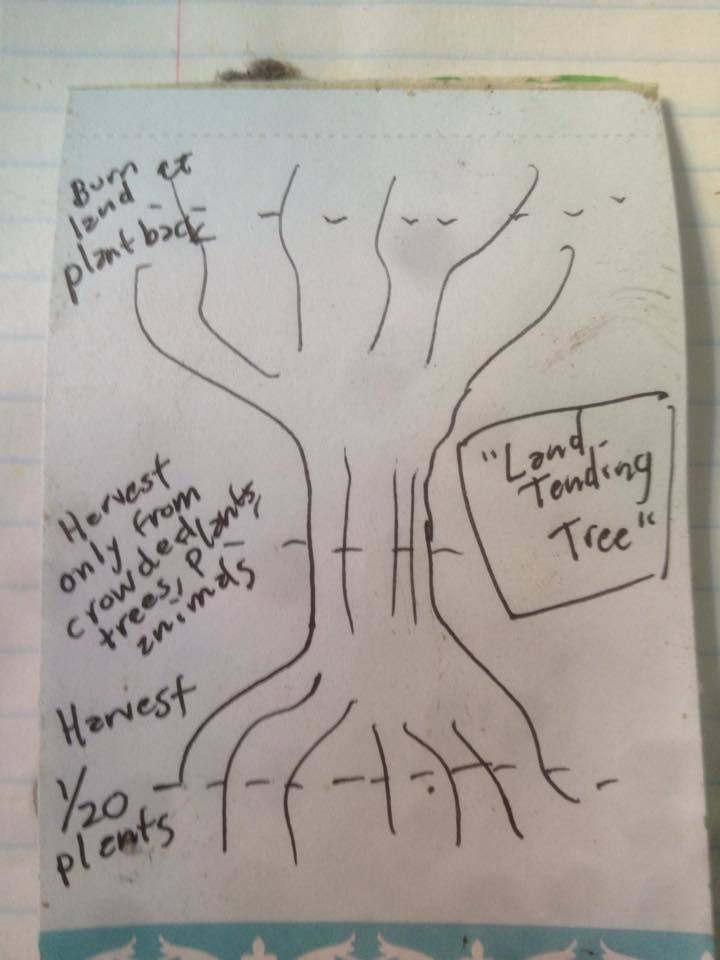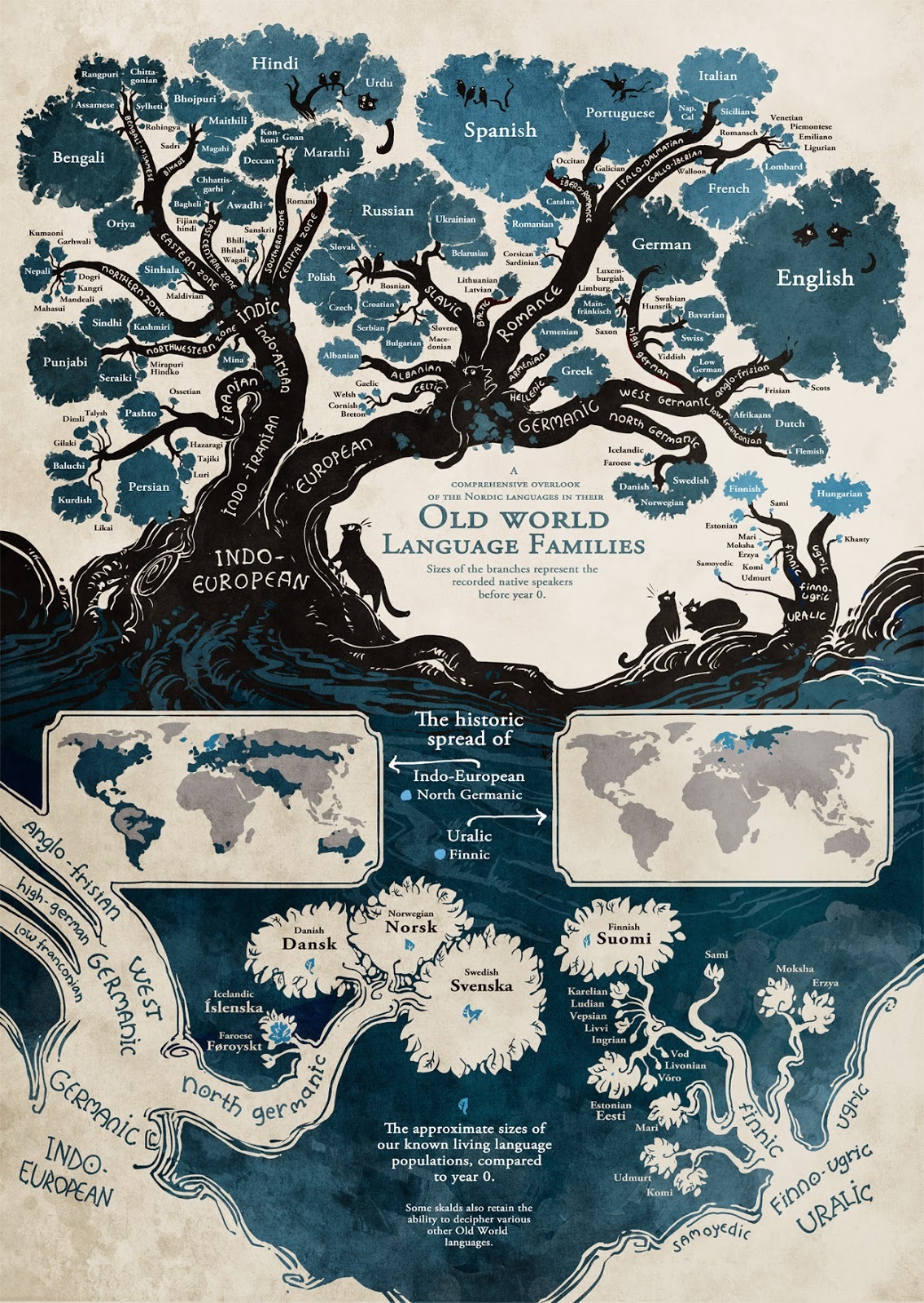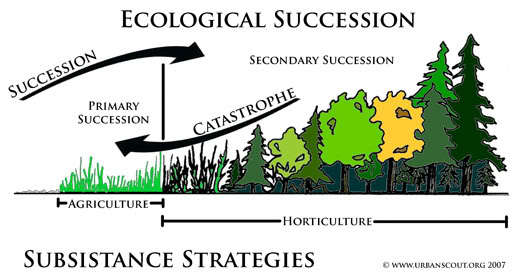I’ve noticed that as rewilding becomes a stronger culture, we’re starting to have more and divergence about what it “means”. What “is” rewilding, what “isn’t”. In other communities of practice and learning that I’m involved in, we’ve come up with a great way of organizing our thinking and cleaning up these discussions/arguments, through what might be called a “fluency tree”.
For example, in my work in language revitalization, I became acquainted with a proficiency scale that looks at your ability to perform in the moment, in the language, rather than your ability to talk “about” the language - grammar etc.
What happens then, is we have a natural emergence of understanding of who has what to offer - who is fluent in what.
For example, in language, you could say there are four levels of broad ability - newbies arrive with memorized words and phrases (“Hola! Yo quiero tacos!”), then build adaptive, live conversational fluency as apprentice speakers (“Where is the bathroom? How much would you pay for this?”), then begin to tell complex stories as journeypersons (“I got lost in Manila, and here’s what happened first…”), then engage in debate and discussion as masters of the language (“I’d like to make three points about the moral implications of this…”).
I think this way of thinking - novices, apprentices, journey persons, and masters, would be a helpful of talking about why folks like Vitalis etc seem to be doing “rewilding wrong” to some - but not to others. Why folks like Finisia are the perfect messengers for some - but overwhelming and paralyzing for others. I think this all goes to where you’re at, what you can do, and how you’re experiencing your rewilding right now.
If you look at this tree, the seedling rewilder needs firm guidance - needs a number and an instruction about a tiny patch of ground (“only harvest 1/20 plants you see”).
As you progress, the sapling rewilder builds their own personal relationships with wild relatives - now they can look at a wild living being and say, “if I harvest you, how will that impact the entire nation of you, and those you rely on? Will you become stronger or weaker?”
The shade-tree rewilder looks at the entire region and thinks, “We must plant back here, it’s time to burn over there.”
Perhaps the old-growth rewilder says, “The original dreaming place where we all come from is saying to burn now, and stop replanting those, though there is nothing I can point to where the land is obviously demanding it.”

How would you test fluency? How do we mark it or map it out? Can you give a few examples of questions that sit on the ACTFL test, and how they might translate to creating a fluency scale to rewilding?
Your edits above definitely help. Though, I have a hard time grasping it all. With the cybertracker fluency scale, things are more cut and dry. I have a hard time seeing how to make something as encompassing as rewilding into a fluency scale. Sure, aspects of rewilding for sure. But the entirety of it? Maybe we divide it into the categories of the board: Land/food, ancestral skills, invisible/village skills. Would that work? Maybe I’m thinking about this not in the way you mean.
There’s at least two ways to proceed.
One) Rewilding is a community of practice. Interview experienced folks who are “innovating at the edge” or folks who we, as a community, feel are sitting at the center of what this community experiences as rewilding. Ask them about how they experience rewilding, what they wish others knew so that they could share their experience.
Two) Thought experimentation - do as you suggest, find what we think are the core concerns of rewilding (land tending, movement, tracking and awareness, village skills, etc.), pick one concern and brainstorm how it looks as one matures with it, from our own collective experience.
We can do both of these at the same time too.
Your tree doesn’t have enough branches. Think about the complexity of a tree that shows the origins and developments of different languages. A Rewilding tree should have enough branches for every specialization, at any degree of proficiency. (Think buds/new growth, vs. older multi-year growth branches). And most people in the rewilding community would be at many different spots on the tree simultaneously.
Ultimately, as rewilding brings us closer and closer to an authentic, complete culture, we (or our great-great-great grandchildren) would all converge towards the trunk of the tree.
But without connection to the roots, (connection to the earth, connection connection to place, to our ancestry, connection to each other) none of this can happen. Without that sense of connection, a branch may as well be lying severed on the ground. (Or–referring to some recent conversations–then it might as well be made of plastic).
Haha, I think Willem’s tree was a quick sketch, and my three categories would be three main branches coming from the trunk that would then split off. Maybe something like this:

Yes, and there’s a greater whole we’re looking at here - a tree of rewilding wouldn’t be a tree of flintknapping. Who cares how good a flintknapper or basket weaver you are, or any particular specialization.
Perhaps it’s helpful to think of this as a description of your immediate community - maybe that’s even key.
Perhaps this tree is a description of the group of rewilders you belong to - perhaps this in and of itself would inspire folks more to combat “mountain man” syndrome and think of themselves as communities of rewilding?
I can see there’s a lot we have to talk about here. Well, buckle up. This’ll take a while I guess. But I think it’s good we’re beginning to talk and think about this.
That is such a beautiful version of the indo-european language tree.
It would be a very interesting project to make a rewilding tree of similar scope.
When you all brought up the subject, I imagined something fairly different. I made this chart of my own philosophical journey, relative to rewilding. My journey has not been a linear one, nor does it represent a final condition. I wonder how other people would describe their philosophical journeys.
NO UNDERSTANDING OF RELATIONSHIPS
Selfish Ignorant Childhood (age 0-8)
Mormon Christianity (age 8-16)
American Bourgeois Consumerism (age 15-16)
Tom Brown Jr. Spiritualism (age 15-18)
-the earth exists for man
-life is a school exam from God
-obedience is rewarded in the afterlife
-no understanding whatsoever of nature or history
-guilt is the predominate theme of my life
-the point of life is to own a lot of stuff
-fake Darwinism
-guru patriarchs
-ideological dependence
-marginalization of experience
-no empathy
-inner life
-patriarchal monogamy
-hunter/gatherers are degenerate savages
UNDERSTANDING RELATIONSHIPS AS COMPLEX SYSTEMS
Scientific Atheism (age 17 to present, with amendments)
Experimental Archeology (age 17-present)
Critiques of Civilization (age 16-present)
Anthropological Egalitarianism/Green Anarchism (age 17-present, plus sense of humor)
Daniel Quinn Buddhism (age 17-present)
Paleo Diet/ Move Nat (still too poor)
Modern Psychology (age 20-25, this field has a long way to go)
Permacutlure (age 20-present, with amendments)
-trust in experience
-ideological independence
-skepticism
-understanding ecology
-understanding history
-understanding needs in relationships
-escape from the patriarchy of absurdity
-learning about actual ancient cultures
-animism as a psychologically healthy way to view the world
-all life is related
-lingering moralism and mechanistic world view
-philosophical polyamory, practical monogamy
NEED FOR RELATIONSHIPS TO BE RECIPROCAL
Derick Jensen Moralism/DGR (age 19-24)
Finisia Medrano Moralism (age 23)
-resurgence of moralism
-great empathy
-unflinching look at history
-willing to carry out radical action
-feminism from the man Jensen
-masculinism from the former man Medrano
-hypocrisy
-victim culture
-emotionally derived imperatives
-the perception of evil
-resurgence of guilt
-'save the world’
-‘planting back’
-paralysis
-attempted polyamory
UNDERSTANDING RELATIONSHIPS ARE ULTIMATELY WITH MYSELF
Alan Watts Zen (age 24-present)
Nietzsche Post Moralism (age 26-presen, with deletions)
Guy McPherson Zen (age 25-present, with skepticism)
Chamberlain Evolution as an Anti-Narrative (since I made this shit up myself, I probably wouldn’t confess ever outgrowing it)
-an understanding and love of irony
-understanding innocence
-understanding unity
-shedding of moralism and the mechanistic world view
-moralism as domestication
-comfort with life’s ambiguity
-comfort with my own “dark side"
-comfort with my own “masculinity"
-comfort finding my own meaning
-abandonment of the ‘save the world’ mentally
practicalnaturalist, I really like your schematic of your philosophical journey. Reminds me of Maslow’s Hierarchy of Needs somewhat. I also really resonate with your last milestone: “moralism as domestication”, “abandonment of the save the world mentality”, “love of irony”, “shedding mechanistic worldview”, comfort with oneself and one’s attributes, etc. Very much where I’m at right now too. Interesting to me also, as I also came into rewilding as part of a long and on-going philosophical journey that was not at all linear, too.
To me rewilding is a spiritual movement. It is the task of understanding our relationship with our own selves. Knowledge is good, skills are great, but they need wisdom in order to be really something. We need what the bear, the beaver, and the deer have known all along: discipline and discernment. To the undiscerning eye these appear to be instinct and mechanism. To the discerning eye, they are attributes of wisdom.
To be honest, I don’t think the end goal of rewilding is any more complicated than an understanding of our self and who we are truly, and then a moving forward into the world now as the witness and steward to our own fate and choice. Self-knowledge sounds overwhelmingly daunting, but perhaps we feel this because it is powerfully simple.
The practice of the wild teaches us about the wild world outside, but it also teaches us of the wilderness that is ourselves. It may be said that we are nature. It can also be said that there is no nature, only us. There is only us in it’s universal, cosmic sense. No masters, no gods looking in from the outside, no dogmas, no laws. Infinity within, and infinity without. What a powerful place to be! And a place of great responsibility requiring… discernment. How are we going to treat ourselves?
So to bring my now dangerously-rambly post back to the original topic: I disagree that a spectrum and criteria-of-achievement can adequately categorize a personal rewilding journey. I think we should break things down into more material categories, much-like the trades and artisanal craft skills to which apprentice-journeyman-master titles are usually (and fittingly) bestowed. Rewilding is just too overarching and intangible as a title all to itself. I mean, hypothetically speaking, I could be a fully wild free-ranging human being without a master, and still not know how to make a friction fire, or shoot a bow. Where does that put me on the spectrum? If we take the meaning of rewilding to be synonymous with its practical skills, we lose the sense of rewilding as a spiritual endeavor and existential pursuit.
It is precisely viewing rewilding as material culture that I see causing all the problems.
Rewilding is not handcrafts.
Rewilding means telling a particular story about the world, that as a side-effect causes the stuff you make with your hands to become gods and grandparents with their own personhood.
Rewilding means belonging to the land.
And the whole point of a “fluency tree” means there are a million roots (ways in) and a million branches (ways to follow the path out to maturity).
Thanks for the feedback, Heyzack.
Willem, myself, and others seem to be on a same page about the importance of the WHY versus the HOW. There are a lot of people making bowdrill fires, but the reasons WHY are so incredibly diverse.
I offered the description of my journey, toward a taxonomy of the diverse WHYS. I must think that personal journeys can indeed be compared and contrasted, even roughly categorized. And I suppose the goal of this would be to avoid misunderstanding and conflict.
At present, there seem to be rampant conflicts between people who are practicing similar skills, but for very different reasons. I have explored much of the territory, but there must be people in mental places I don’t comprehend yet, and I risk offending them if I mis-estimate their motives.
I’ve thought I could work well with certain camps, where people practiced what was appealing on the surface, only to find their perspectives and motives opposed to my own. I should have avoided those camps. I want to have productive discussions and debates, but we shouldn’t need to convert each other. People need the safety of commonality, as well as the challenge of difference and change.
But I would laugh if there became some formal system of certifying foragers or tanners, as there is now for trackers. Discernment, and I like that word, is part of the game. If we all had titles to represent the progress of our expertise, we’d be depriving each other of learning discernment. Knowing who is good, at what they do, is a thing, in itself, to get good at.
-Kyle
Certifying foragers or tanners would be the diametric opposite of what I have suggested.
However, since folks mostly seem uninspired by this notion, I’m losing interest in it myself.
Moving on -
Yoga already did this for yoga. I still think we should do this for rewilding. We just need to draw it out.
another one. Geez Yoga.
Well, if we’re to move forward with what I’m proposing, what is important is that we understand what I’m offering up first. Before agreeing or disagreeing with it.
The fundamental issue is rewilding, no matter what skill you’re using to enact it, looks different as you experience the increasing complexity of it. Another metaphor:
Your personal or group rewilding paradigm moves through succession stages. From exposed earth due to cultural cataclysm, into field filled with herbaceous plants (i.e. "weeds) who know how to heal bare earth, to sparse stands of nitrogen-fixing trees such as alders and poplars with short life spans, to second growth forests, to old growth forests broken up by a mosaic of everything that has come before - meadows, young forests, and so on.
Each of these things isn’t just different in the details, it’s a whole 'nother organism. It is a whole different order of complexity. Hence the aptness of the term “old-growth cultures”. We’re not just talking about people who live “close-to-the-earth” - the modern simplistic romantic conceit of native lifeways - we’re talking about intricate invisible treasure houses of oral traditions, ceremonies, and relationships that accomplish elegantly the ordering and nourishing of the human-land-spirit body.
As I mentioned before, even if you only studied the bow drill, if you studied from a “rewilding” paradigm it would take you through these stages. How you harvest the materials, where you source them from, tools you use to carve them, what you do with the coal, your conception of the purpose of the parts and whole of the bow drill set - as simple fire-making tool all the way up to universe-making ceremony that would take a week of 12 hour days to tell the story of - you are walking along an arc from bare earth to old-growth in learning the bow-drill, and every other part of your rewilding consciousness is pulled with it.
The power of this tool - a rewilding “Tree of Wisdom” let’s say - is that you can’t skip any stages. If you find yourself sneering at someone for abandoning their coal - because at “Journeyman” level a common story is the coal is a baby that holds all possibility (stories of the future) and ancestry (stories of the past) - you’ll realize that neither you or they or ready for this compassionate and generous understanding and burden.
Another way of thinking about this, is self-other-family-community. In rewilding terms:
- Self. Discovering modes of self-healing and expression.
- Other. Discovering modes of relational healing and expression - lovers, friends, etc. Your yard.
- Family. Discovering modes of family/ancestral healing and expression. Your neighborhood.
- Community. Knowing what branch of the web of rivers you are on - discovering modes of village/clan/multiple-ancestries/allyship healing and expression. Your watershed -your bioregion.
I’ve thrown up a bunch of stuff here - but none of it is “the answer”. The point is to begin to think nonlinearly - not in terms of certification, or whatever, but in terms of observing the complexity of what you/we are able to nourish and generate within and between us.
the is about complexity, not goals. A tree’s trunk is only as wide as is necessary to hold up its branches - and will never hold more than those branches. A sapling must add wood, concentric rings, to become a shade tree. this is not a linear path but a massive undertaking observable by anyone.
Yeah. That’s kinda what I thought.
Calm down. I only have so much time to work on this. It’s in the queue. 
I love the succession model, the layering of complexities. Maybe we have an illustration more along those lines? Each new phase has more complexity?

